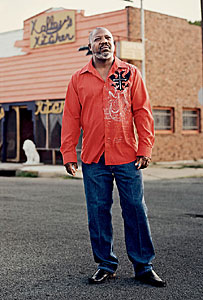Pushing a 'new' gospel in Port Arthur? Really?
 Regular GetReligion readers may have picked up, through the years, that I spent my teen years in the polluted Texas refinery town to end all polluted Texas refinery towns -- Port Arthur. I went to high school with the younger brother of Janis Joplin and, trust me, I have always understood the roots of her anger about her hometown. Click here, folks. There was a time, just before I hit middle school, when physical educational classes were optional for many students with breathing problems. It wasn't safe to exercise out in that nasty local air. And the source of many of those health issues? Don't ask.
Regular GetReligion readers may have picked up, through the years, that I spent my teen years in the polluted Texas refinery town to end all polluted Texas refinery towns -- Port Arthur. I went to high school with the younger brother of Janis Joplin and, trust me, I have always understood the roots of her anger about her hometown. Click here, folks. There was a time, just before I hit middle school, when physical educational classes were optional for many students with breathing problems. It wasn't safe to exercise out in that nasty local air. And the source of many of those health issues? Don't ask.
Anyway, I would like to recommend a long feature story in the September issue of The Oprah Magazine that is set in Port Arthur. It tells the story of a heroic community activist (and soul-food entrepreneur) who is fighting -- literally -- for the lives of people who live on the wrong side of this bleak city, where unemployment and pollution create a deadly one-two punch. The key is a federally subsidized housing project called Carver Terrace that sits -- yes, literally -- on the other side of a fence line from two aging refineries. It would be hard to find a more monstrous environmental threat looming over a weakened and powerless community.
You say I am making this sound too black and white, too simplistic? Well, on one level that's true:
As the refineries grew, the land around them became less and less residentially desirable, although it continued to be developed through 1970 for low-income housing. An urban-renewal report from the 1960s reveals that in 1956, 1,480 families lived in a 60-block area of the West Side that needed rehabilitation even then: “Seven white families and 1,473 Negro families,” it says. Prince Hall and Louis Manor, more low-rise barracks, went up right behind Carver Terrace, and two Port Arthurs had already emerged -- one black and depressed by its proximity to refining; the other white, with comfortable homes and cars, and proof of our absolute dependence on it.
But now there is Hilton Kelley, his restaurant, his passion, his smarts and, yes, his faith.
Reading this story, I just knew that the faith shoe was going to have to drop, since this story is about a real person in a real place -- Texas. How would anyone mobilize Texans to help the poor and to help themselves without a strong dose of faith? Who has the power to speak a word of judgment to the powerful in a factory town?
God, that's who.
Sooner or later, you just knew that Kelley had to go to church. However, I find it interesting (and appalling) that this heroic figure had to go all the way to nearby Beaumont to find a church that would march with him to the front lines. That's what this story suggests.
This raises a question, for me: Where are the Port Arthur churches? I mean, my father was the pastor of an inner-city Southern Baptist church near downtown (it is now a Buddhist temple) that stood its ground and ministered to its integrated neighborhood for years. I know that most of the white churches fled to the suburbs during the mid-1970s. I know the scene.
But there are NO churches in Port Arthur -- black or white -- involved in this story? Why not? Were religious leaders silent, when asked about Kelley's cause?
As it turns out, that congregation in Beaumont plays a crucial role, since the story informs us that it is the place where Kelley "first learned the ropes of environmental activism."
 This church, in other words, is at the center of this drama.
This church, in other words, is at the center of this drama.
On the fence line, common wisdom holds that you raise your voice for God and shut your mouth for oil. It’s a Do not bite the hand that feeds you kind of edict, and it sticks. But at the Shining Star Baptist Church in Beaumont a decade ago, ... God and oil were uncharacteristically clashing. The Reverend Roy Malveaux had been trained by the activist Denny Larson -- executive director of Global Community Monitor, a California-based environmental justice and human rights organization -- to assess pollution levels with a device made from a five-gallon bucket, a pump, and a plastic bag. Through Malveaux and Larson, Kelley learned the bucket, too. He read up on the chemical compounds in the air and learned what they do to the body. It was all around him: millions of pounds of volatile emissions. Hexane, xylene, toluene. He started knocking on doors. “Do you know what you’re breathing?” he’d ask, and he’d tell them -- methanol, benzene -- and they’d look at him, angry or helpless or indifferent, like, Yeah, but what can we do? What can you do?
Kelley wouldn’t settle for ineffectual help-line dialing. He would become all their voices if he had to, and take all those years acting, writing plays and poems, all that time performing, and channel it into a new kind of gospel for his community. He attended a media-training boot camp in Austin, run by the League of Conservation Voters, and learned to write press releases and get the attention of reporters. “They’d wake us at 3 A.M.,” he says, “and make us write about breaking stories to understand the urgency of things.”
Putting his new skills into action, he showed up on the steps of city hall in Port Arthur towing a coffin. He painted it black, with an image of a smokestack on the lid, and spoke with conviction to the television and newspaper reporters he had gathered. “This is what our kids are ending up in, and nobody’s doing anything about it,” he remembers saying. “And I charge the local government here for a lot of our kids becoming ill and dying and ending up in boxes like this.” In a later incident, as Kelley tells it, when Port Arthur’s then mayor, Oscar Ortiz, suggested to a reporter that a massive shipment of VX nerve agent waste, headed for incineration at a local facility, was as safe as bathwater, Kelley, who was staunchly opposed to bringing the toxin to town, promptly told him to go bathe in it.
Now, the one thing I want to challenge in that gripping passage -- the flaw that points to the one serious hole in this story -- is symbolized the claim that what Kelley did was create a "new kind of gospel" for his endangered community.
Really? You are saying that the faithful in that Baptist church don't think that the regular Gospel with a Big G has anything to say about helping the poor and the powerless? Are you saying that activism that lit a fire in Kelley's soul had no religious content? No Bible content?
Sadly, this fine story is silent on that front. Yes, there's a ghost.
It's clear that religious faith is part of this story. We can see that in the details provided. What we needed was one or two more voices, a glimpse at the Gospel message behind this prophet's passion. In other words, the team that produced this story SAW the religion, but did not GET it. They could not grasp what they were seeing and hearing.